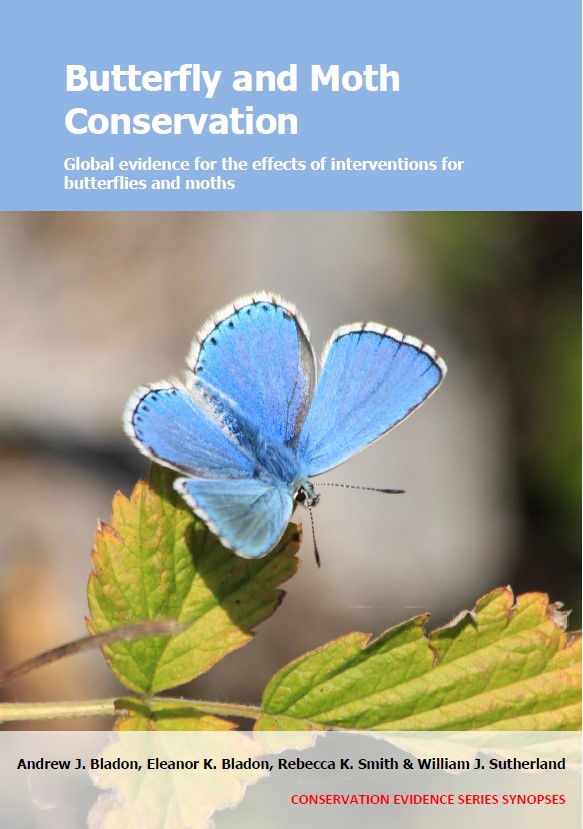Actions to conserve biodiversity
We have summarised evidence from the scientific literature about the effects of actions to conserve wildlife and ecosystems.
Review the evidence from the studies
Not sure what Actions are? Read a brief description.
Search for evidence
e.g. "frogs chytrid"
152 Actions found
Refine
Hide
152 Actions found
Download Actions
| 0 selected |
|
Order results by:
| Action | Effectiveness | Studies | Category | |
|---|---|---|---|---|
|
Provide buffer strips to reduce pesticide and nutrient run-off into margins, waterways and ponds Action Link |
Awaiting assessment | 1 |
|
|
|
Use genetically modified crops which produce pesticide to replace conventional pesticide application Action Link |
Awaiting assessment | 1 |
|
|
|
Stop using pesticides as seed dressings and sprays in flower beds and greenspace Action Link |
Evidence not assessed | 1 |
|
|
|
Use low intensity lighting Action Link |
Awaiting assessment | 1 |
|
|
|
Use shielded “full cut-off” lights to remove outwards lighting Action Link |
Awaiting assessment | 1 |
|
|
|
Manage perennial bioenergy crops to benefit butterflies and moths Action Link |
Awaiting assessment | 1 |
|
|
|
Grow native trees within perennial crop plantations Action Link |
Awaiting assessment | 1 |
|
|
|
Leave unharvested crop headlands within arable fields Action Link |
Awaiting assessment | 1 |
|
|
|
Manage rice field banks to benefit butterflies and moths Action Link |
Awaiting assessment | 1 |
|
|
|
Replace non-native species of tree/shrub with native species Action Link |
Awaiting assessment | 1 |
|
|
|
Create young plantations within mature woodland Action Link |
Awaiting assessment | 1 |
|
|
|
Remove tree canopy to reduce pond or waterway shading Action Link |
Awaiting assessment | 1 |
|
|
|
Reintroduce mammals as ecosystem engineers Action Link |
Awaiting assessment | 1 |
|
|
|
Install artificial dams in streams to raise water levels Action Link |
Awaiting assessment | 1 |
|
|
|
Mark the location of webs or caterpillars before mowing Action Link |
Awaiting assessment | 1 |
|
|
|
Protect in-field trees Action Link |
Evidence not assessed | 1 |
|
|
|
Plant more than one crop per field (intercropping) Action Link |
Evidence not assessed | 1 |
|
|
|
Protect greenfield sites or undeveloped land in urban areas Action Link |
Awaiting assessment | 2 |
|
|
|
Apply ecological compensation for developments Action Link |
Evidence not assessed | 2 |
|
|
|
Change season/timing of prescribed burning Action Link |
Awaiting assessment | 2 |
|
|
|
Leave some areas unburned during prescribed burning Action Link |
Awaiting assessment | 2 |
|
|
|
Mechanically remove mid-storey or ground vegetation to create fire breaks Action Link |
Awaiting assessment | 2 |
|
|
|
Stop using herbicides on pavements and road verges Action Link |
Awaiting assessment | 2 |
|
|
|
Maintain traditional orchards to benefit butterflies and moths Action Link |
Awaiting assessment | 2 |
|
|
|
Manage vineyards to benefit butterflies and moths Action Link |
Awaiting assessment | 2 |
|
Download Actions
| 0 selected |
|

Butterfly and Moth Conservation - Published 2023
Butterfly and Moth Synopsis
Watch this search
If you are familiar with RSS feeds, please click the button below to retrieve the feed URL:
RSS feed for this searchIf you are unfamiliar with RSS feeds, we would suggest reading this BBC article.
Unfortunately, due to the number of feeds we have available, we cannot provide e-mail updates. However, you could use tools such as Feed My Inbox to do this for you.
What are 'Individual studies' and 'Actions'?
Individual studies
An individual study is a summary of a specific scientific study, usually taken from a scientific journal, but also from other resources such as reports. It tells you the background context, the action(s) taken and their consequences.
If you want more detail please look at the original reference.
Actions
Each action page focuses on a particular action you could take to benefit wildlife or ecosystems.
It contains brief (150-200 word) descriptions of relevant studies (context, action(s) taken and their consequences) and one or more key messages.
Key messages show the extent and main conclusions of the available evidence. Using links within key messages, you can look at the paragraphs describing each study to get more detail. Each paragraph allows you to assess the quality of the evidence and how relevant it is to your situation.
Where we found no evidence, we have been unable to assess whether or not an intervention is effective or has any harmful impacts.





)_2023.JPG)














